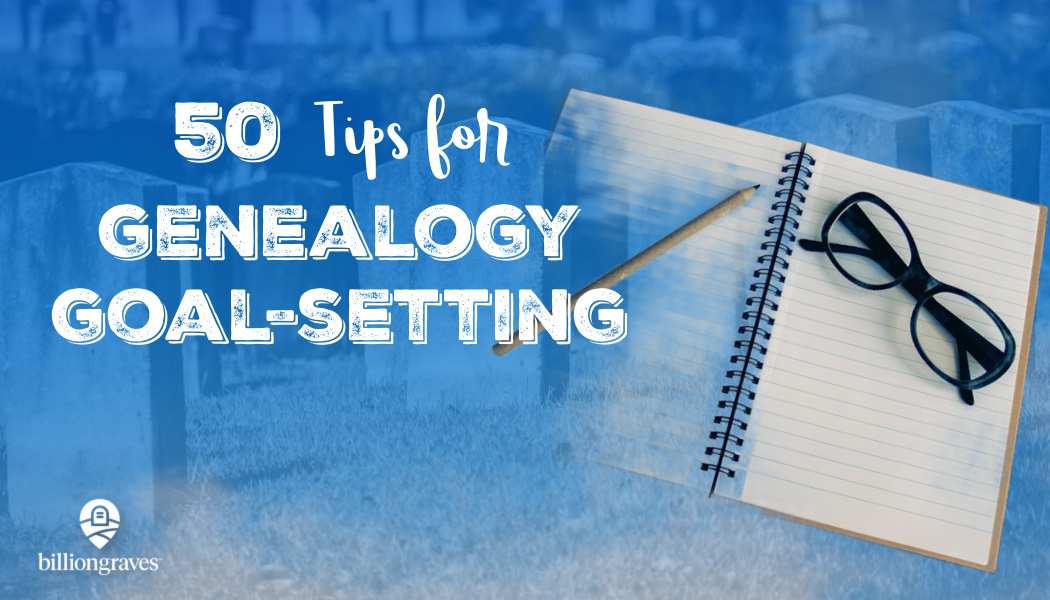Genealogy goal-setting is not as common as setting goals to get organized, lose weight, or advance your career. But if you are a genealogist it may be one of the best things you could do this year.
If you have never set genealogy goals before I invite you to get ready by reading through these 50 tips for genealogy goal-setting. As you read, select some that interest you the most, write them down, and set dates to accomplish them.
Productivity studies show that it is best to select 5 or 6 goals to act on at a time to maintain focus. Trying to accomplish too many goals at once can become discouraging. Your list should be short enough that you will be able to recite it nearly from memory.
In order for goals to be attained they need to be more than a wish.
- Write your genealogy goals down.
- Choose 5-6 genealogy goals to act on at a time.
- Review your genealogy goals at least weekly.
- Set specific dates to complete each genealogy goal.
- Share your genealogy goals with someone who might help you accomplish them.

Organize Your Paperwork
Tips 1-5 for Genealogy Goal-Setting
1) Organized paperwork is the foundation for successful genealogy. The first step to organizing you genealogy is to bring all your papers into one area. Gather all the birth and death certificates, photos, maps, and stories.
2) Decide which paper documents need to be saved and which may be scanned and tossed. It’s a good idea to keep original vital records. This includes birth, death, and marriage records. Vintage handwritten letters and original photos are precious keepsakes. Census records are readily available online, so paper copies should be tossed. Printed pages from books that are now digitalized may be thrown out.
3) Share duplicate photos with extended family members.
4) Put vital records and photos in archival safe page protectors in binders. Label each binder with a family surname.
5) Keep working documents in a filing system. Label the files with surnames for each branch of your family. Working documents include anything that you have not yet established as a fact, but may be good clues for your research. Examples may include letters from distant family members, information from one of your DNA matches or from people with your same surnames for which you haven’t yet figured out how you are related.

Conduct Interviews
Tips 6-10 for Genealogy Goal-Setting
6) Start by making a list of the oldest living members of your family. You’ll want to capture their memories before it’s too late.
7) Call to set up appointments to interview your grandparents, great-aunts and uncles. Keep visits brief if they tire easily. Then set up a follow-up meeting. Personal visits are best, but if their hearing is good enough, phone calls or video conferencing can work.
8) Figure out how you are going to record your interview. Paper and pen are great for recording essential details like names and dates, but when it comes to story-telling you’ll want to use a recording device. Most smartphones come with a voice memo app that will capture up to 15 minutes of stories.
9) Prepare a list of questions. My earlier blog post, Christmas Genealogy Interviews has a list of 100 genealogy interview questions you could choose from.
10) Share. Post the answers to your genealogy interview questions online for your entire family to enjoy. FamilySearch offers free family trees and the Memories section has a place for written stories as well as recorded oral interviews.

Use a DNA Kit
Tips 11-15 for Genealogy Goal-Setting
11) If you haven’t ordered a DNA Kit yet hop to it!
12) Once you have received your DNA results make use of DNA matches. Starting with closest relationships first, contact each one to see if you can work together to figure out how you are related.
13) People who share a common ancestor with you will have some of the same DNA segments found in your own DNA. These relatives are called DNA Matches. MyHeritage allows you upload raw data from other testing services. Then they will send you emails with your DNA Matches for free. Why would you want to do that? Their huge database is about twice the size of GEDmatch and Genesis combined. This will expand the size of the pond you are fishing in.
14) Contact your DNA Matches to see if they have additional sources, photos, or stories about your common ancestors. They may have information that they have not yet posted online.
15) Use MyHeritage’s feature My Ancestral Places together with BillionGraves’ FamilyPlots to find your ancestor’s grave. My earlier blog post on How to Use Your DNA to Find Your Ancestor’s Grave explains how to do it.

Picture Perfect
Tips 16-20 for Genealogy Goal-Setting
16) Are your genealogy photos here, there, and everywhere? Are some in albums, some stuffed in shoe boxes, and some on the wall? Gather them all in one spot to start organizing.
17) Choose a large area in which to work, such as on a table or a bed, where you can spread the photos out. Write your family surnames on pieces of paper. Sort the photos onto the papers.
18) Then take each pile of photos and put them in order by year. File them in archive-safe photo boxes.
19) LABEL, LABEL, LABEL! Photos are invaluable when they have names and dates with them. But without labels, they will be worthless in a generation or two when no one can remember who the people are anymore. If you choose to write on the back of the photos be sure to use archive-safe pens.
20) If you can’t identify some of the people in your photos, pack the pictures up and take them along when you interview older family members or to your next family reunion. Ask questions about the photos. Even if family members can only identify the town or house, some of the people, or an approximate year, their clues may help.

Find Your Focus
Tips 21-25 for Genealogy Goal-Setting
21) It’s easy to get sidetracked when doing genealogy. For example, if you find a marriage record that lists the parents of the bride and groom you need to decide if you will continue to pursue information about the married couple or follow the lines of the parents. Find your focus by deciding what will be done right away and what will be done later.
22) Keep a record – digital or on paper – of surnames and records to return to later.
23) You can spread the joy of family history work and get greater results if you delegate. Sometimes family members want to help with genealogy but they don’t know what to do. Keep a list of specific tasks they could do for you and then ask them to report back with the results. For example, ask family members to conduct interviews with older family members, photograph gravestones at a specific cemetery, or label photos.
24) Teamwork will not only bring genealogical success, but it will also bring your family closer together. My brother and I talk on the phone daily when we are working on a family history puzzle.
25) Consider choosing a specific family surname to work on each month for the entire year. Then break down the research tasks that need to be done for that surname and spread it out to establish weekly and daily goals.

Set a Timer
Tips 26-30 for Genealogy Goal-Setting
26) It’s easy to go chasing down rabbit-holes when you are doing genealogy. Set a timer to keep yourself on track. This will keep you from getting overwhelmed or sidetracked.
27) When you come to #50 at the end of this blog post, scan the list again to choose your genealogy goals for this year. Set a timer for 15 minutes to choose your goals. Boom. Done.
28) Set a timer for 10 minute genealogy goals:
- call Great-Aunt Jane to set up an appointment to interview her
- label five family photos
- write in your own journal about an event you do not want to forget
29) Set a timer for 20 minute genealogy goals:
- label a dozen file folders with family names and put them in alphabetical order
- choose a cemetery to adopt on BillionGraves
- write a story about one of your ancestors and post it in the Memories section of FamilySearch
30) Set a timer for 30 minute genealogy goals:
- stop at local cemetery and take photos of two rows of gravestones with the BillionGraves app on your smartphone
- check FamilySearch for one or two of your ancestor’s census records and attach them to your tree
- conduct a telephone interview with an older relative

Decide to Decide
Tips 31-35 for Genealogy Goal-Setting
31) Procrastination was born in the Valley of Indecision. Decide to decide.
32) Set up a filing system for your genealogy paperwork.
33) Decide to only handle papers once. Then set a rule for yourself that if you pick it up, you must either file it or digitally scan it and throw it away.
34) The BillionGraves blog post, 3 Genealogy Christmas Gifts, shows how to make a creative family history binder that is based on your FamilySearch fan chart. Creating binders will help you decide what to do with your important documents and vital records.
35) Decide today on your genealogy goals for the coming year. As soon as you have finished reading this article pull out your calendar and plug in realistic, achievable goals.

Start a Research Log
Tips 36-40 for Genealogy Goal-Setting
36) Keep a record of what you have already researched so you don’t waste time repeating the same steps you have already taken. In your log, whether digital or paper, set up columns for the name of the person you researched, where you searched for information, contacts made, and whether the result was successful or not.
37) In your research log include the specific problem you are searching for so you don’t have to figure it out again if you come back to it months or years later.
38) List libraries, websites, and books that you have already searched. Also keep a record of phone numbers of people you have called, including relatives and DNA matches.
39) Your research log may be as simple as sticky notes on a large calendar on the wall. Set specific dates for contacts you will make. Remove the sticky notes when you have accomplished the task or move them to another date as needed.
40) Return to your log again and again to find areas where you can make new attempts at research. New records are constantly being digitalized and indexed. Sources that were not available yesterday may be easy to find today.

Plan Excursions
Tips 41-45 for Genealogy Goal-Setting
41) Take a trip to your family’s ancestral home.
42) Photograph your family’s gravestones or adopt their entire cemetery at BillionGraves.com/adopt.
43) Visit older relatives so they can “show and tell” about your family.
44) Contact the county courthouse and library in your ancestor’s hometown to see what records they may have available that will help with your research.
45) If genealogy excursions are beyond your budget, plan a virtual trip to your ancestral homeland using GoogleMaps and your ancestral cemetery using BillionGraves Plus Family Plots.

Be Consistent
Tips 46-50 for Genealogy Goal-Setting
46) When violin master Shinichi Suzuki was asked by his young students how often they needed to practice he replied, “Only practice on the days you eat!” Consistency is the best way to develop a talent. Imagine that instead of eating three meals a day, you ate 21 meals once a week – all at once. Don’t do it! Likewise, spread your genealogy goals out as evenly as possible month by month over your year. Then break them down into smaller digestible portions to be accomplished each day.
47) Sometimes we fall into the thought pattern that genealogy can be put off until we are old – or older. Not true. The future is fragile. Fit your genealogy goals into your daily life starting today.
48) Can you spare 15 minutes a day for genealogy? Over the year that would add up to 5,475 minutes or more than 91 hours. That’s a lot of family history!
49) Doing genealogy isn’t a sprint, it’s a marathon. When you are setting your genealogy goals, plan to do something each day for the rest of your life. Otherwise, it’s too easy to think that someday you will do something – and then someday may never show up.
50) When working on a large project I often remind myself, “Finished, not perfect!” It is better to complete a task than to get stuck on one of the steps trying to perfect it. So choose one of these 50 tips and get started with consistent efforts on your genealogy goals.
Volunteer
If you would like to take gravestone photos, click HERE to get started. You are welcome to do this at your own convenience, no permission from us is needed. If you still have questions after you have clicked on the link to get started, email us at Volunteer@BillionGraves.com.
Happy Goal-Setting!
Cathy Wallace


